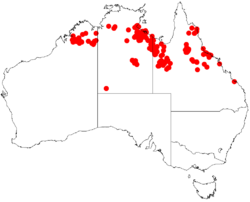Biology:Acacia hemsleyi
| Acacia hemsleyi | |
|---|---|
| Scientific classification | |
| Kingdom: | Plantae |
| Clade: | Tracheophytes |
| Clade: | Angiosperms |
| Clade: | Eudicots |
| Clade: | Rosids |
| Order: | Fabales |
| Family: | Fabaceae |
| Subfamily: | Caesalpinioideae |
| Clade: | Mimosoid clade |
| Genus: | Acacia |
| Species: | A. hemsleyi
|
| Binomial name | |
| Acacia hemsleyi Maiden
| |

| |
| Occurrence data from AVH | |
Acacia hemsleyi is a tree or shrub belonging to the genus Acacia and the subgenus Juliflorae that is endemic to tropical parts of northern Australia .
Description
The tree or shrub is slender, has rough bark and typically grows to a height of 2 to 5 metres (7 to 16 ft). It blooms from July to September producing yellow flowers.[1] The slightly fissured to shredded looking bark is present on the trunk and larger limbs with the angular upper branchlets that are glabrous and have resinous ridges and brown triangular stipules that are 1 to 2 mm (0.039 to 0.079 in) in height. The evergreen phyllodes have a linear to narrowly elliptic and linear-oblanceolate shape and can be slightly curved or straight. The phyllodes are 4 to 14.5 cm (1.6 to 5.7 in) in length and 3 to 14 mm (0.12 to 0.55 in) with two or three prominent main nerves and two or three secondary nerves.[2]
Distribution
It is native to an area in the Kimberley region of Western Australia where it is found along riverbanks and rocky creek beds and around permanent water sources.[1] The range of the species extends across the top end of the Northern Territory and into northern Queensland where it is also found on river beds and creek banks as well as sandy beaches in mangrove communities growing in gravelly sands.[2]
See also
References
- ↑ 1.0 1.1 "Acacia hemsleyi". FloraBase. Western Australian Government Department of Parks and Wildlife. https://florabase.dpaw.wa.gov.au/browse/profile/3367.
- ↑ 2.0 2.1 "Acacia hemsleyi". World Wide Wattle. Western Australian Herbarium. http://worldwidewattle.com/speciesgallery/hemsleyi.php. Retrieved 8 August 2019.
Wikidata ☰ Q15287246 entry
 |

